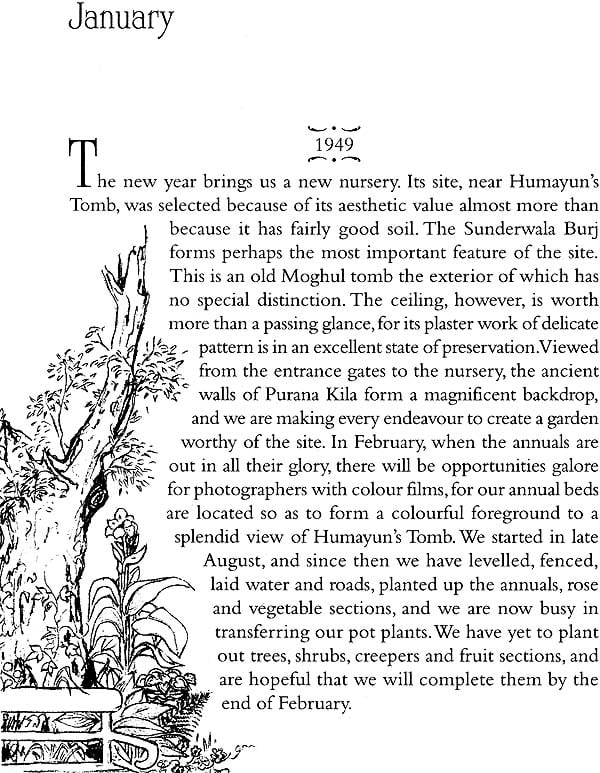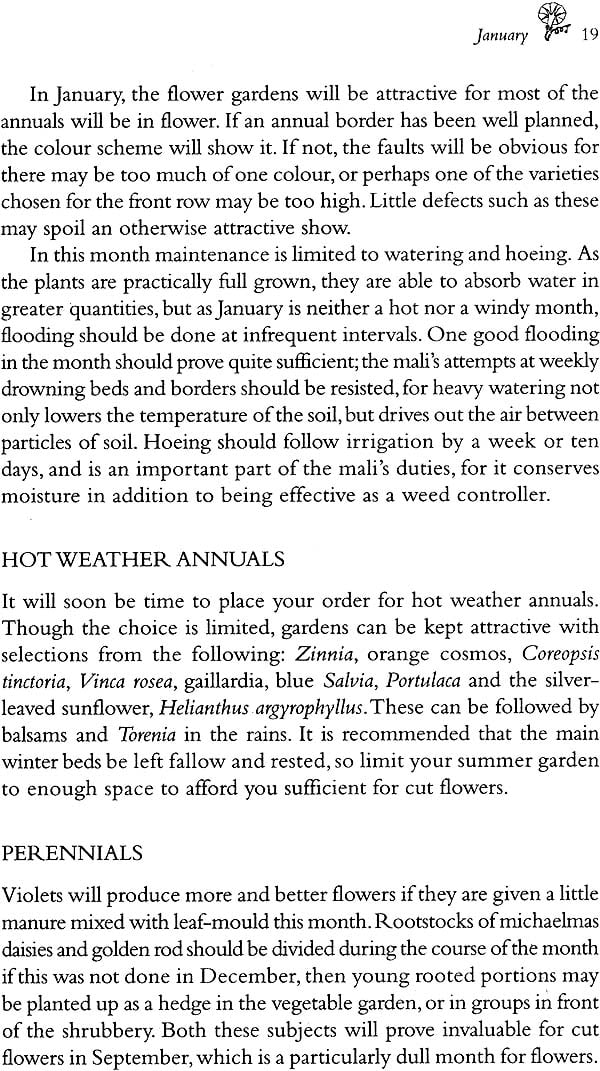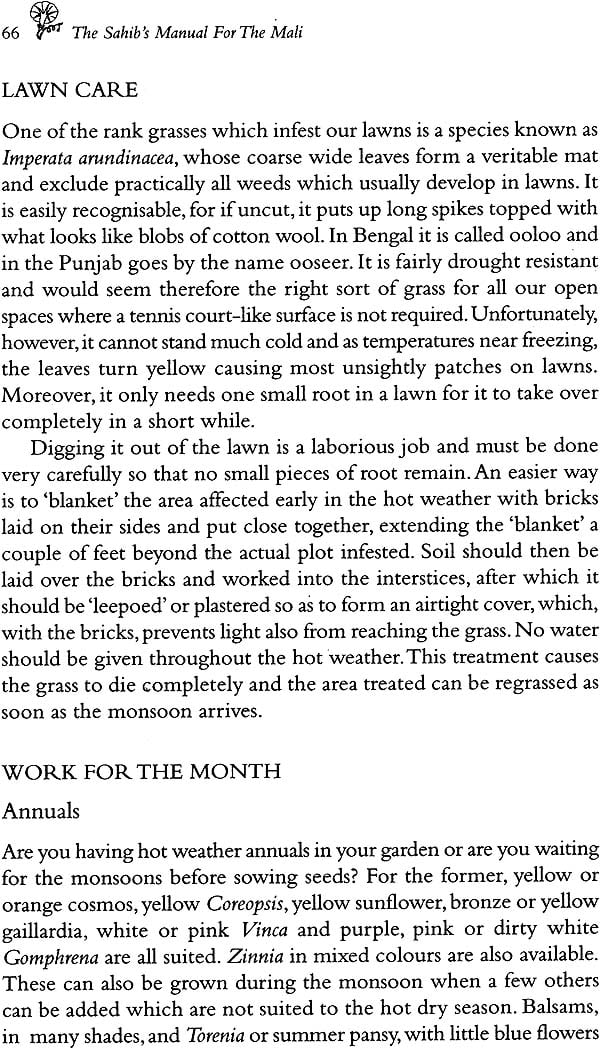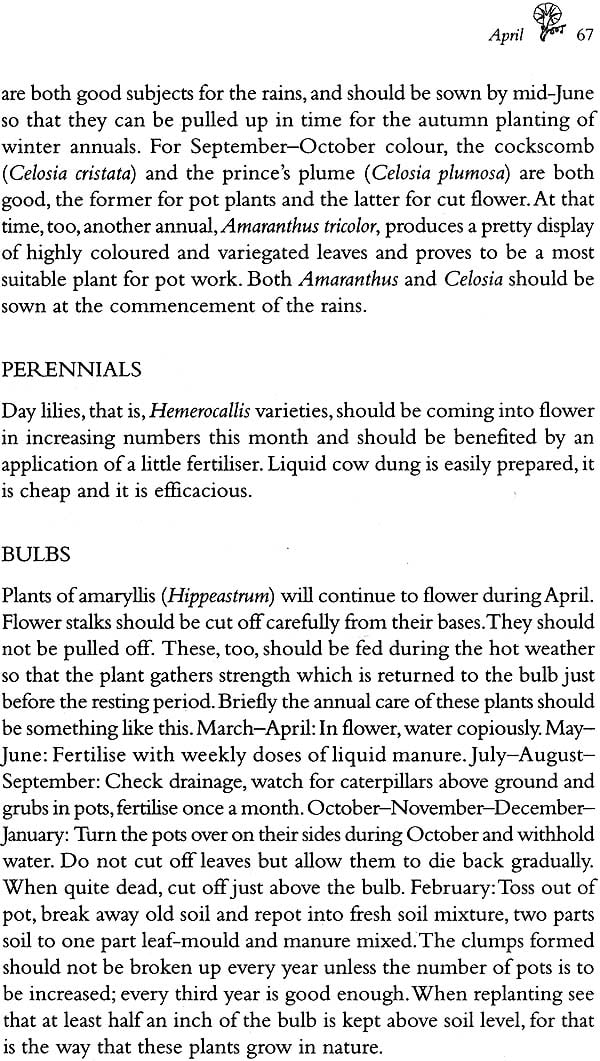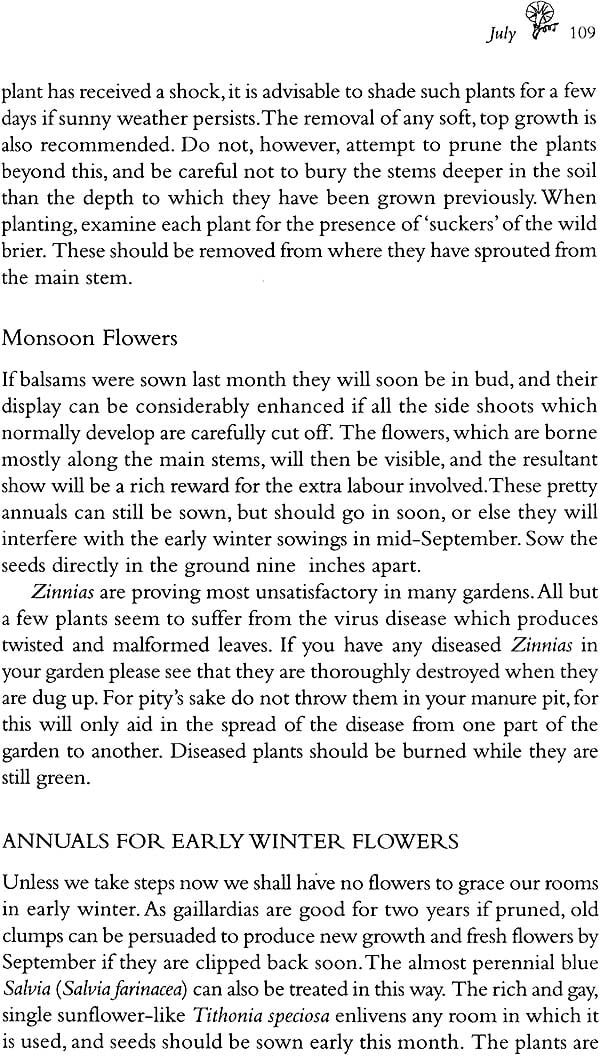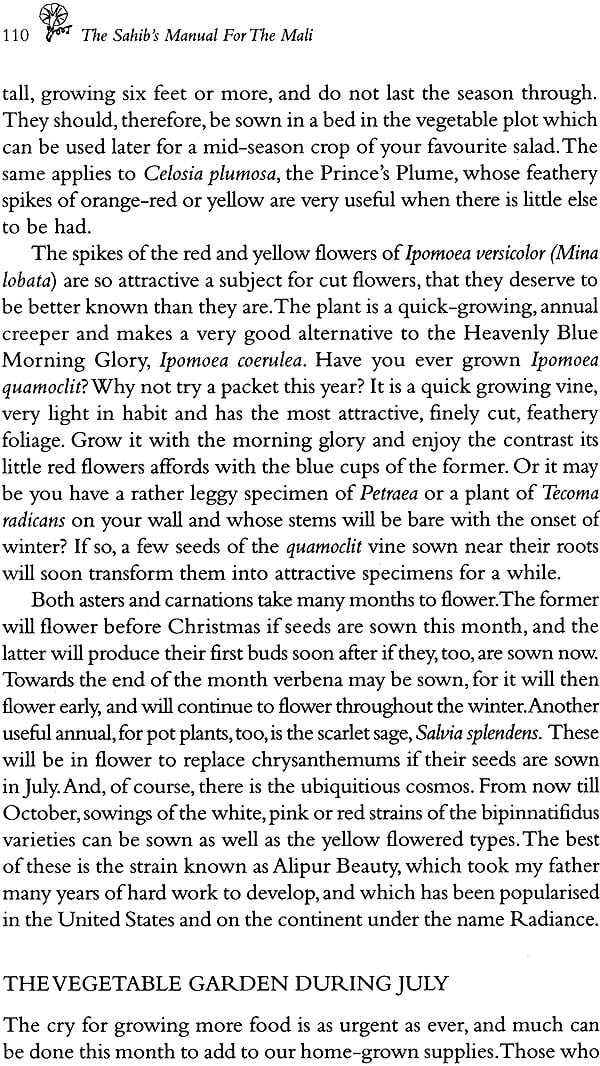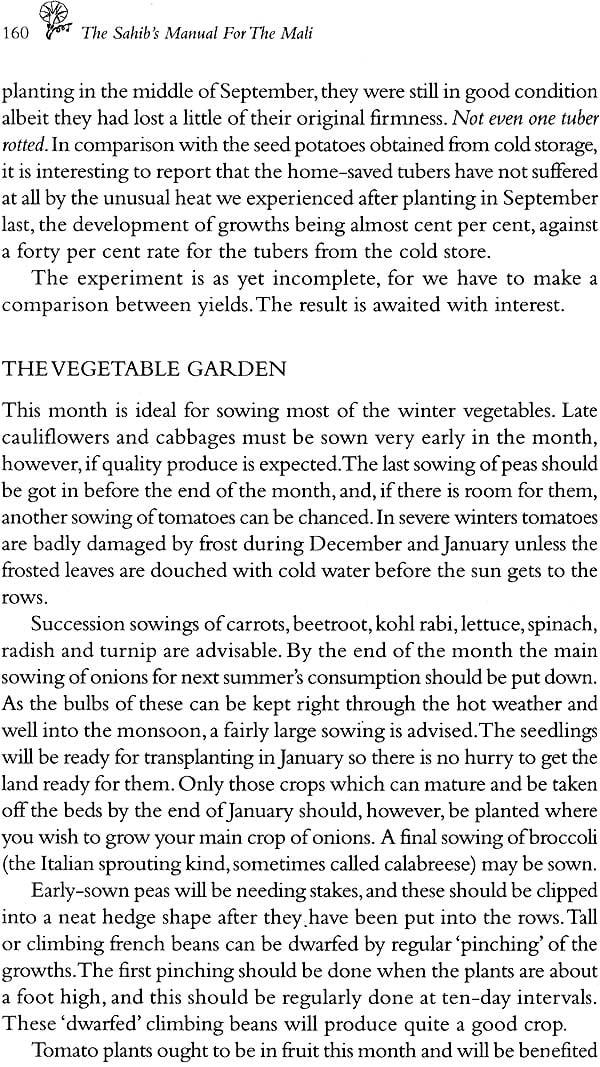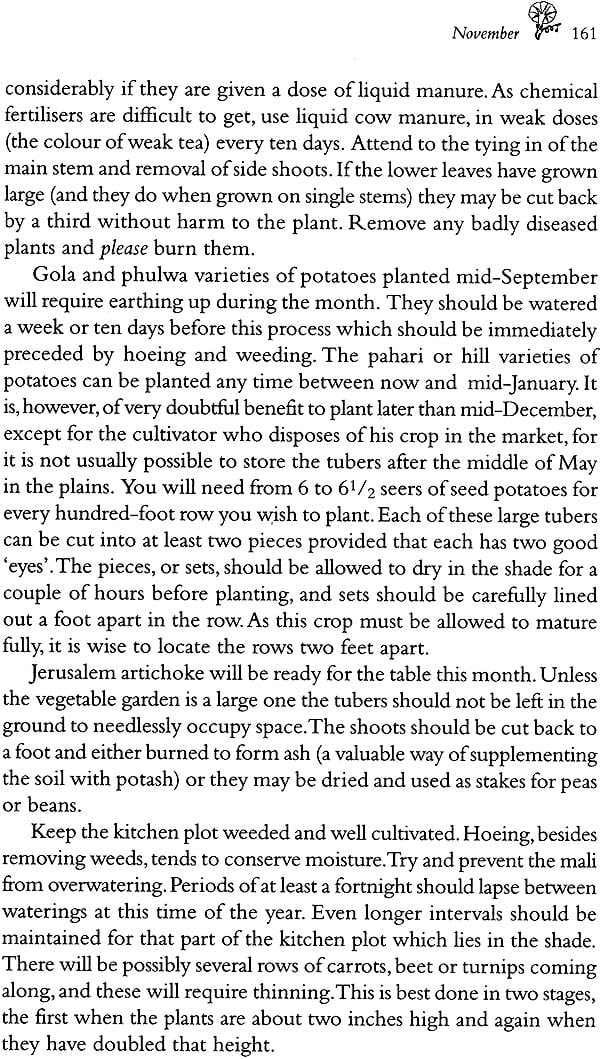
The Sahib’s Manual for The Mali (Everyday Gardening in India)
Book Specification
| Item Code: | NAH589 |
| Author: | Alick Precy-Lancaster |
| Publisher: | Permanent Black |
| Language: | English |
| Edition: | 2011 |
| ISBN: | 9788178242422 |
| Pages: | 240 |
| Cover: | Paperback |
| Other Details | 8.0 inch x 5.0 inch |
| Weight | 220 gm |
Book Description
‘The average mali we have seems unable to appreciate the difference between light watering, heavy watering, flooding and drowning, he being most adept at the last, for his commonest error is to lay the hose in a corner and leave it till the water has filled the bed entirely, overflowed and watered the adjacent lawn and nearby road indiscriminately’.
Amateur gardeners and those who like gardens but cannot tell phlox from petunia: Alick Precy-Lancaster’s delightful guide is for everyone. It explain not only the What and the How but also the all-important Why. Even as he dispenses practical gardening tips, the leisurely charm of Precy-Lancaster’s writing evokes an India far away and long ago. He takes us through garden work month by month: follow his advice, and whatever space you have—terrace or balcony, kitchen window or rambling lawn—will be full of leaf and flower.
Alick Precy-Lancaster was the last Englishman to hold the post of superintendent of Horticultural Operation, Government of India. After independence, his chores included maintaining 15,000 avenue trees on roads and clipping 150 miles of hedges.
This book was put together at the suggestion of Professor Narayani Gupta, who had preserved all the old copies of Mr Percy-Lancaster's monthly bulletin Garden Chat. I am very grateful to her for giving me the opportunity to do this enjoyable exercise. I hope readers will think that it was also a worthwhile one.
During the time that we were handling the papers of the late Percy-Lancaster we developed a great friendship for him, and for that reason as well as for more formal and legal ones, we wished to contact some member of his family. We were helped in our search by Mrs Bunny Gupta, who did us a great service by tracking down his grand-daughter Mrs de Klerk in South Africa. Mrs de Klerk readily agreed to the publication of this book. She also sent us some extra material about his life. We are very grateful to her.
We seldom find so much technical information and practical wisdom presented in such an easy and charming manner; and these papers, after nearly sixty years, and in spite of a certain distance from present-day realities, still add up to a valuable gardening manual for us in India.
I am grateful that the book was popular enough to warrant this new edition. But while there is a sense of gratification, there is also some mortification as we present it in paperback. About a year after A Sahib 5 Manual for the Mali was published, I heard from some relatives of the Percy-Lancasters in South Africa, who had chanced upon the book, that naming Sydney as author in the first edition had been a major error on my part. The author of ‘Garden Chat' was actually Alick, the son of Sydney Percy-Lancaster. It seems that there were four generations of Percy-Lancasters, all horticulturists, and two of them were prolific writers. I console myself thinking that it is through such oddities and twists that the publishing history of a book grows richer and more interesting. I have now corrected this error.
Some years ago a small bundle of ragged, yellowing papers fell into the hands of the Delhi historian, Dr Narayani Gupta. They were the fifty-year-old copies of a modest, informal monthly bulletin called Garden Chat brought out by A. Percy-Lancaster, who was Superintendent of Horticultural Operations, Government of India. He started the bulletin in January 1949, and it was addressed mainly to housewives struggling to create gardens around their New Delhi bungalows. The aims and objects of the bulletin were clear and limited; it was to offer help and advice about garden work; and it was so timed that every issue gave instructions for that particular month. The advice was so useful that within two months of its inception, Garden Chat was in demand as far away as Bengal and the Punjab.
Percy-Lancaster protested that his instructions were applicable only to Delhi and its immediate surroundings; but he did admit that with slight adjustments to suit different climates, his bulletin could be useful in many places in north India. Because the bulletin explained not only the what and the how, but also the all-important why, it became a source of real education. Indeed, collected under one cover, the material in Garden Chat adds up to one of the most comprehensive and educative books on gardening in India. Readers of the following pages may be tempted to think of Percy-Lancaster as the good-natured man next door who liked pottering in his garden. They would be only half right. He was certainly good natured but he was no potterer. He was a scientist and a technician who worked and experimented in his open-air laboratory.
Percy-Lancaster was the last Englishman to hold the position of Superintendent of Horticulture. His main responsibility seems to have been to make, and keep, Delhi looking green. It was the kind of job where you were unnoticed and unthanked while things went well, but could be roundly blamed if there was a hitch. His routine chores included little items like planting and maintaining 15,000 avenue trees on municipal roads, maintaining and clipping 150 miles of hedges, laying out new gardens, caring for the lawns and hedges in the spacious gardens of government servants. Apart from routine work, those exceptional times made many exceptional demands. Mr Percy-Lancaster had the sad responsibility of laying out the park around the samadhi of Mahatma Gandhi; while soon afterwards, his Department was caught up in the desperate business of helping to accommodate the lakhs of refugees from Pakistan who had made their way into Delhi.
| Editor's Note | IX | |
| Introduction | 1 | |
| 1 | January | 18 |
| 1949 | 18 | |
| 1950 | 22 | |
| 1951 | 30 | |
| 1952 | 34 | |
| 2 | February | 37 |
| 1949 | 37 | |
| 1951 | 39 | |
| 1952 | 43 | |
| 3 | March | 49 |
| 1949 | 49 | |
| 1951 | 57 | |
| 4 | April | 63 |
| 1951 | 63 | |
| 5 | May | 70 |
| 1949 | 70 | |
| 1950 | 72 | |
| 6 | June | 83 |
| 1949 | 83 | |
| 7 | July | 94 |
| 1949 | 94 | |
| 1950 | 105 | |
| 1951 | 106 | |
| 8 | August | 122 |
| 1949 | 122 | |
| 1951 | 134 | |
| 9 | September | 137 |
| 1949 | 137 | |
| 1951 | 149 | |
| 10 | November | 156 |
| 1949 | 156 | |
| 11 | December | 172 |
| 1949 | 172 | |
| 1951 | 178 | |
| 12 | Trees | 181 |
| 13 | Creepers and Climbers | 200 |
| 14 | Cut Flowers | 204 |
| 15 | Tub Gardening | 207 |
| 16 | Manure | 209 |
| 17 | Pests | 213 |
| 18 | Index | 219 |
